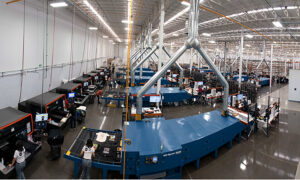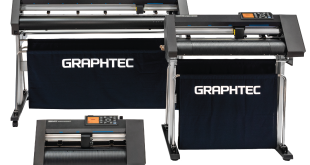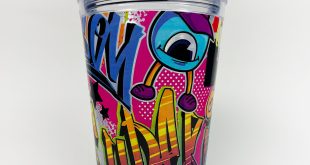
Phil Oakley has been an integral part of Kornit’s UK team since he joined in February 2020. P&P editor Melanie Attlesey speaks to the man himself about how the textile industry is changing and what part Kornit is playing during this ongoing transformation.
Although Phil has only worked in the textile industry for the last 18 months, he has actually spent the best part of three decades working in print.
Recognising that the textile industry is on the cusp of change, or as he puts it in its ‘teenage years’, Phil left his role at HP and joined Kornit on the eve of the global COVID-19 pandemic.
“This market does not feel as mature as the retail, point of sale and large format graphics market, which was where I came from,” says Phil. “I feel that there is still a lot of industrial maturity yet to happen.”
It was the onset of the pandemic that Phil says has truly accelerated not only Kornit’s business, but the textile industry as a whole.
The IMRG Capgemini Online Retail Sales Index reported that online sales in the UK fell by 9.1% in May 2021 versus a year earlier. However, this most recent comparison is measured against a 61% boom in growth recorded in May 2020, which was driven by the first peak of the pandemic. If you take bricks and mortar retail as a comparison, a study by management consultancy Alvarez & Marsal, in partnership with Retail Economics, found that pre-tax profit margins for retailers in six European countries, the UK included, fell from 6.4% to 4.5% in the last 10 years and is forecast to drop to 3.2% by 2025. It is likely that the growth in e-commerce is the main contributing factor to this fall. This study also forecasts that, if the pandemic had not have happened, the profit margins in the countries studied would be 3.7% by 2025.
“Cracks in retail shopping were already showing prior to the pandemic, but it was just decimated during the pandemic with everyone forced to shop online. Coming out of COVID retailers have recognised that they need to make the online shopping experience better,” says Phil.
Changing climate
It’s in this changing climate that brands and retailers are having to adapt. When the consumer now wants a garment they head online, order several different styles and sizes, and return what they don’t want. In the same token, wanting next day delivery and free returns. But how do retailers and brands provide this service in a quick, sustainable and cost-effective way?
Phil says the answer lies in on-demand printing. When Phil first started at Kornit his main role was to speak to the fulfillers about what benefits Kornit’s range of direct to garment printers could bring to their business. Instead, the onset of the coronavirus pandemic and the change in consumer buying habits, now means he spends much more of his time speaking to brands and retailers to bring about a shift in their manufacturing process and educate them on how the on-demand printing method can benefit their business model.
“I feel that the COVID-19 pandemic has just magnified some of the issues that the old supply chain model faces. The old supply chain model is not fit for the modern world,” explains Phil.
This model means the manufacturing of millions of garments and expecting that a percentage of this will go to landfill or will be sold at a loss. Retailers build their profitability around this wastage. For example, to achieve the profit they want on 600,000 garments, they potentially need to make around a million, factoring in an expected waste of 40%. Businesses are beginning to change their attitudes to having stock. They are beginning to think about the potential of creating 150 new designs a week and working out which are best-sellers, without holding stock of these 150 designs. This is made possible through a mixture of digital sales communications such as Instagram, Tik Tok and an e-commerce website, plus utilising on-demand printing.

Functioning e-commerce website
A well-functioning e-commerce website is key for brands and retailers. Without this it is impossible to sell anything. Recognising this as a key component in helping to change the supply chain model, Kornit completed the acquisition of Custom Gateway, now known as Kornit X, in August 2020.
The Kornit X cloud platform handles all steps of efficient on-demand production, allowing brands and retailers to grow considerably through digital transformation. This acquisition leapfrogged Kornit from being just an equipment supplier, to a company that can now offer a complete solution for on-demand printing.
Phil says: “Kornit X is the platform that roots, through discussion, collaboration and engagement of the brands and the fulfillers, the work from the consumer placing the order through to the fulfiller, that will print, pack and ship the product on behalf of the brand. Kornit X was definitely the missing link that was needed to connect the brands and retailers with our army of fulfillers. We see it as the operating system of a new textile industry.”
Kornit X is the whole eco system. Brands and retailers can have a website that offers personalisation and customisation, with a backend that feeds orders through to a fulfiller who can provide fast turnaround times while producing one-off prints. Brands are now recognising that if they can build personalisation and customisation into their product categories, they see a reduction in the amount of returns they receive.
“I think there will be further development of this, with the onset of artificial intelligence and virtual 3D fitting rooms. Technology that will enhance the personalisation experience. Making garments that the customer actually wants to keep,” Phil adds.
Sustainability and profitability
The question remains about how to do this sustainably, but yet profitably. “The knock-on effect of customers continuing to purchase four items to return three means that hundreds of millions of garments continue to be manufactured in the Far East, which contributes to the rising global pollution levels. A few years ago, a customer said to me, ‘Phil, don’t talk to me about sustainability unless you can save me a pound or make me a pound’. That was difficult, because it was a soft benefit. Now you can talk about how retailers can completely change their supply chain to benefit the customer, while significantly improving their bottom line,” says Phil.
This is all about digital and on-demand printing on an industrial level. Kornit has big ambitions to transform the UK’s textile industry into a sustainable one, all while being ahead of the goal to exceed $500 million global annual revenue by the end of 2023.

The fulfillers that have grown with Kornit over the last 18 years are now very proficient printers. They understand the technology inside out and they are scaling. Phil says that these fulfillers have struggled to get brands and retailers to understand the on-demand model, because that’s not their model. This is where Kornit steps in. “We support the fulfillers that have grown with us and in turn educate the brands and retailers about stockless fulfilment. In return creating a sustainable supply chain model, with minimal waste,” he adds.
Kornit’s objective at the start of this journey was to transform the textile and fashion industry one impression at a time so that it becomes sustainable, and the company is certainly well on its way to reaching that goal.
 Printwear & Promotion The Total Promotional Package
Printwear & Promotion The Total Promotional Package




